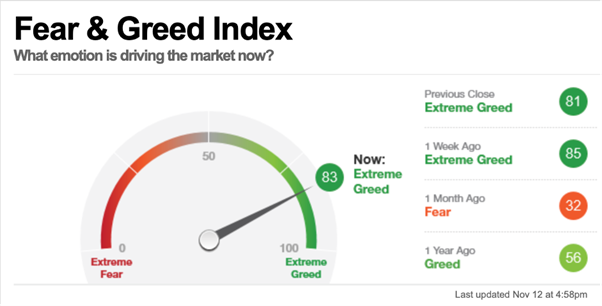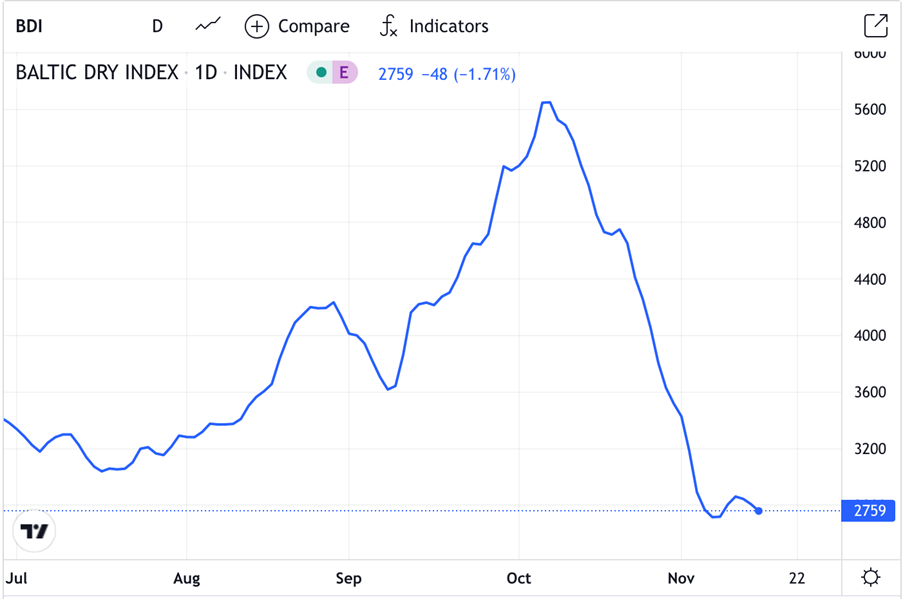Mark Clubb, Executive Chairman at TEAM Plc (LON:TEAM) reflects on market movements in October and November 2021; provides some historical context; and explains how TEAM Plc’s International Equity Fund is perfectly positioned to capitalise on improving equity markets and the many high-quality companies emerging as leaders.
So, what did you think of the 2021 annual Halloween Horror Movie, Ghostbusters?
It was a bit spooky and scary at points but the Ghostbusters or “Growthbusters” won through.
Despite all the frightening incidents and sometimes depressing news, each of the top three U.S. equity market indexes closed October at all-time highs. November has seen a continuation of that trend.
Everyone has recovered and there is no better measure of that than the CNN Fear & Greed Index.

When the market pulled back on Halloween fears in early October, the Fear & Greed Index fell to nearly 30.
This level represents “extreme fear.” And in the past, it has often taken many months to recover.
But now, just over one month later, the index is back at 83, deep into “extreme greed” territory. So much for the horror movie.
We are back into “buy the market” and this is additionally evidenced by the increase in fund flows. According to Bank of America, investors are on course to put more money in shares this year than in every other year since 2001 combined.
The TEAM International Equity Fund also participated in the improved equity market, rising 4.1% on the month. 63% of the Fund is invested in high quality U.S. listed companies. Companies we all use every week if not day of our lives.
Again, despite the apparitions, both the US Central Bank (Fed) and the Bank of England are keeping interest rates the same for now, i.e., close to zero. Personally, I think Fed Chairman Powell wants his job renewed by President Biden and will strive to not rock the boat by keeping monetary policy super accommodative (i.e. interest rates low).
But the major “Proton Pack”, the fictional energy-based capture device, used for capturing and entrapping ghosts in the Ghostbusters film, was the third quarter earnings reports announced during October.
According to FactSet, as at time of writing, the average earnings surprise in the S&P 500 so far is 10.3%, and the S&P 500 is on track to achieve 36.6% average earnings growth and 15.8% average sales growth.
Back to the earnings. For Q3 2021 at the time of writing 82% of S&P 500 companies have reported a positive EPS surprise and 75% of S&P 500 companies have reported a positive revenue surprise.
And here’s what FactSet is anticipating for the end of the year:
Analysts expect earnings growth of more than 20% for the fourth quarter and earnings growth of more than 40% for the full year.
Admittedly, these above average growth rates are due to a combination of higher earnings for 2021 and an easier comparison to weaker earnings in 2020 due to the negative impact of COVID-19 on the majority of the market’s companies.
If we compare earnings this year with 2019 (skipping the low numbers in 2020), the compounded earnings growth rate for all companies is still 16.4% per year, which is exceptional.
We haven’t seen growth rates like that since 2012. That year the S&P went up 13.4% followed by 29.6% in 2013.
However, these recent results have also revealed which companies are increasingly emerging as market leaders and which are not.
The high quality companies with strong fundamentals are breaking further way.
One of the biggest headwinds for earnings has been the global supply chain bottleneck. After all, if your product doesn’t make it to market, you can’t sell it. We are all individually well aware of this frustration.
Central Banks are also blaming the current inflation we have on these supply chain bottlenecks but see the consequent inflation as “transitory”.
So, the easing of global bottlenecks should further improve the outlook for revenues and earnings with potentially decreased inflationary pressures.
The good news is that supply chain issues would appear to be easing.
Freight costs are coming down, which indicates that bottlenecks are easing. The WCI Composite Freight Benchmark rate shows the cost of a 40-foot shipping container fell about 9.5% from $10,500 in September to about $9,500 in October (RBC Capital Markets).
And the Baltic Dry Index, a benchmark for the cost of shipping raw materials by sea, has fallen almost 40% since early October and has stayed at the lows.

However, let us assume inflation is not just about “supply chain bottlenecks”.
Inflation is fatal for fixed income investors.
Here is some arithmetic:
If rising inflation caused 30-year bond yields to rise from 2.0% to 3.0% over the next 12 months, the value of that bond would fall 20%.
If 30-year yields doubled from 2.0% to 4.0%, the price of the 30-year bond would fall more than 35%.
If the above outlooks hold true, then the best place to be invested is in high quality growth companies. Yes, they have an initial rough patch. But ultimately, they win through in a big way.
Why? Because they can pass that inflation onto us, the consumers and they have the financial strength to weather higher borrowing costs (interest rates). Many have cash not debt anyway.
In inflationary times, it is the high-quality companies that sell in-demand goods and services that can protect their profits by increasing their prices.
Yes, these pass-through costs aren’t great for you and I as consumers, but this is what separates top-tier businesses (and their shares) from the average.
Consumers are still willing to pay for the goods/services of quality businesses when prices are high. Not so much for average businesses.
So, think personal hygiene products like soap, shower gel, shampoo and deodorants or toothpaste. How about cosmetics? (Procter and Gamble, Unilever, J&J, L’Oréal and Estee Lauder).
What about your leisure time? Are you going to cut Disney Plus?
You might delay getting a new smartphone (Apple) but not for that long. Internet connected devices have become essential items. Then there are the companies that make the critical parts such as Nvidia and QUALCOMM.
Then there are today’s other essentials, Microsoft, Google and your cyber security products and services (like Crowdstrike), not to forget the “cloud” (Microsoft and Amazon)
We own these “castles” in the TEAM International Equity Fund and they are doing rather well.
Now, I wouldn’t be surprised if recent highs reached in equity markets take a pause in the next week or so, but that’s good. Pauses refresh the market. They also give you time to invest rather than chasing higher prices.
Let’s stick to the historical facts.
From 1928 to 2020 the principal equity market, the U.S. S&P500 has returned on average 9.8% annually.
It is entirely reasonable to expect difficult periods, periods of 10% to 20% corrections. These bear markets should not be a surprise. It is alarming and frightening when it happens. Think “Edward Scissorhands” or “The It”.
It spooks investors out. Don’t be spooked. Take a deep breath, it will almost certainly be alright. (More on “almost” later)
Just think of the last few years; the Global Financial Crisis, and the sequel, the terrifying Covid pandemic induced bear market. Those crises were fabulous opportunities to invest for long term wealth creation.
The bear market following the 2008-2009 Global Financial crisis lasted less than 18 months with most of the decline occurring in the first 6 months and then shares started rebounding immediately.
It’s been a similar story for every significant decline since, culminating with the COVID-19-related crash last spring. That was among the sharpest stock market drops in history. But it lasted just three months, and stocks were already back at all-time highs by the summer.
The closest thing to a real bear market most of us have experienced was the dot-com bust early 2000’s. The overall market fell around 50% over a two-and-a-half-year period from early 2000 to late 2002.
Why does this matter? Because bear markets aren’t always so brief.
The most famous example occurred during the Great Depression. (This is the “almost” bit).
The U.S. stock market crashed in October 1929. In total, shares lost nearly 50% of their value from September through November that year, and then another 80% over the next three years.
While the worst decline was over, the bear market went on for another 10 years or so.
Investors suffered another seven more corrections ranging from 20% to as much as 50% over that time.
And the market didn’t make a new high until late 1954, nearly 25 years after the previous peak in 1929.
Notwithstanding the above, and the world was very different then, particularly coming out of the true real-life horror of the First World War, in most bear markets, there was only and only one thing to do. BUY SHARES in high quality fundamentally strong companies that will survive and continue to prosper.
One last “Breaking News” item.
China’s ambassador to the United States read a letter from Chinese President Xi Jinping at a dinner hosted by the National Committee on U.S.-China Relations in Washington on Tuesday, last week. It said in part that China is willing to “enhance exchanges and cooperation across the board” with the United States and bring relations between the two back on track.
Everything could fall apart, of course. But this could represent the beginnings of a shift in relations that gives both countries the breathing room they need. That’s good for global equities.
When we have these “white knuckle” periods think of the Baron Rothschild quote, “Buy when there’s blood in the street, even if the blood is your own.”
TEAM plc (LON: TEAM) is a new wealth, asset management and complementary financial services group. With a focus on the UK, Crown Dependencies and International Finance Centres, the strategy is to build local businesses of scale around TEAM plc’s core skill of providing investment management services.






































